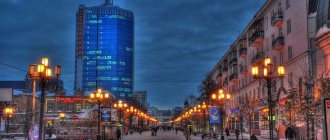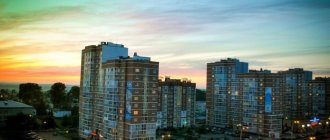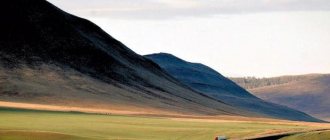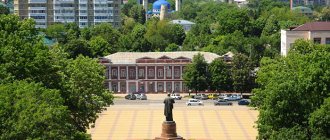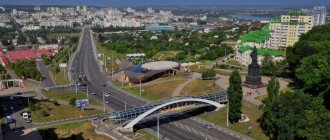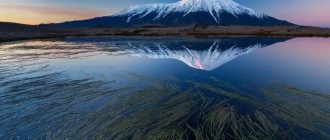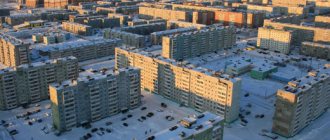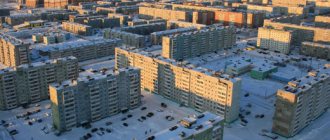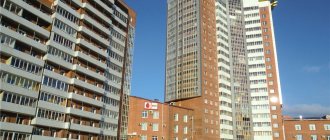The Urals are known for geographically separating Europe and Asia. The basis of the region is the Ural Mountains, which extend from south to north. They connect the shores of the Arctic Ocean with Kazakhstan.
The center of the federal district and the unofficial capital of the Urals is Yekaterinburg.
The name “Ural,” according to researchers, comes from the ancient dialect of the Bashkir language. Means “elevation”, “mountain”, “belt”. The Bashkirs even have a legend about how the territory was formed. In ancient times, there lived a giant who wore a large belt decorated with gems. It was heavy and wide - the giant got tired of wearing the belt, took it off and laid it flat on the ground. This is how the Ural Mountains appeared.
Most of the names of Ural places, cities, villages, and rivers are associated with ancient legends. Many of them are arranged in Bazhov’s famous “Tales”.
The region is rich in varieties of plants, animals, birds, and reptiles. The mountains themselves have been a source of iron ore, emeralds, copper, salt, oil and gas and other minerals for many centuries.
The tourist attractiveness of the Urals is due to the traditions and legends of numerous peoples, rich multi-layered culture, and unique nature.
For ease of route planning, we have marked all the mentioned cities and attractions on the map:
Where is the Urals located on the map of Russia
The Urals are located simultaneously in the Asian and European sides of the world. The mountains stretch from the very North to the southern Kazakhstani regions, and their length is 2500 km. The mountains themselves are a system of massifs and ridges of different heights, the peak reaches 1700 m, and the lowest point 600 m.
The Urals are divided into:
- Southern Urals (Bashkortostan, Kurgan, Chelyabinsk and Orenburg) . Here the steppe gives way to forest.
- Middle Urals (Sverdlovsk and Perm) . There is taiga and forest everywhere.
- Northern, Subpolar and Polar Urals (Nenets Autonomous Okrug and Komi Republic) . In these areas, the taiga gives way to tundra.
The area of the Urals is 781.1 thousand km2, which is 4.5% of the area of Russia.
Ufa is an old and interesting city in Bashkiria
The exact date of the founding of Ufa is unknown, but archaeological finds have shown that settlements existed here back in the Paleolithic era. On maps of the 14th century, the settlement of Paskerti was listed on the site of modern Ufa, but the founding date of the city is generally considered to be 1574, since it was at this time that it was first mentioned in chronicles.
Today it is one of the most significant Russian centers of science, economics and culture, where a large number of monuments await tourists. The most notable ones date back to the last two centuries: the monument to Salavat Yulaev, the largest cathedral mosque in Russia Lyalya-Tulpan and the Nativity of the Virgin Mary Church.
Borders, regions adjacent to the Urals
Due to the fact that the Urals are located over a large territory and pass through all climatic zones (except for deserts and semi-deserts), the boundaries of these lands are divided into several territorial types.
According to weather conditions, the Urals are divided into:
- Polar. This is where the border between Europe and Asia lies, which is located outside the Arctic Circle. This territory originates from Mount Constantine Stone (492 m), followed by the Greater and Lesser Chora-Maha, Khara-Pe, Parisey-Pe, and Sibilei. These mountains stand at the end of the Urals, and their average heights are 900-1200 m. The highest point of the Polar Urals is Mount Payer (1499 m). The climate in this area is harsh, with strong gusts of wind. Summer is very short with frequently changing weather. The mountains are snow-covered until the height of summer. In the Polar part of the Urals there is the deepest Ural lake - Big Shchuchye, which was formed by nature itself in the depths of the depression at 136 m.
- Subpolar . This is the highest point of the Ural Mountains, and the length of this area is 240 km. The highest mountain is located here - Narodnaya, whose height is 1894.5 m. In the mountains of the Subpolar Urals you can often find glaciers; these mountains are considered the most beautiful of the entire Ural belt. The mountainous area alone is 32,000 km2. The climate is sharply continental, a large area of mixed forest and taiga, the deep-water Lake Mansi (38 m) and Lake Torgovoe originate from the mountains.
- Northern . In this part of the Urals there is a high point, Mount Telposis (1617 m). The winds blow here, so outwardly the mountains are quite flat, and the peaks are covered with snow even in summer. This area is very difficult to access for tourists due to the remoteness of transport routes. It is this area that is famous for the Dyatlov Pass incident; the mysterious death of these peak conquerors has still not been solved.
- Average . Here is the lowest mountain of the entire Ural mountain range. The highest mountain ranges are Starik-Kamen (755 m) and Shunut-Kamen (726 m). But in this area there are many rivers, along the banks of which beautiful cliffs rise.
- Southern. In this territory there are again high mountains, the main one is Yamantau, whose height is 1640 m. The mountains of the Southern Urals have a length of 550 km, ending with small mountains in Guberla. The Southern Urals are rich in beautiful lakes, the cleanest of which are Turgoyak and Zyuratkul.
The territory of the Urals is also divided according to the principle of the location of the Ural Mountains:
- Upper Urals (this includes the territories of Pai-Khoi, Polar and Subpolar Urals).
- Central Ural (North and Central part of the mountains).
- Lower (Guberlya and Ilmen Mountains).
Parks, entertainment and more
Ski centers of Ekaterinburg
- GRK "Uktus" - Ekaterinburg, st. Winter, 27/1. There are five ski slopes ranging from 400 to 1200 meters in length. The height difference is from 50 to 100 meters. Equipment rental - from 100 to 500 rubles.
- VGC "ZimaGor" - Ekaterinburg, Sibirsky Trakt, 2. The cost of classes with an instructor will cost from 500 to 14,400 rubles. To ski independently, you need to purchase passes from 3 thousand rubles.
- Mount Deciduous - EKAD, 23 km. Offers 4 tracks with a height difference of 70.5 meters, length from 150 m to 8 km (ski). Rental of various equipment - from 70 to 500 rubles per hour.
- GLC "Park Iset" - Verkhnyaya Pyshma. 3 tracks for skiing, snowboarding and tubing. Equipment rental - from 100 to 1350 rubles.
Hot Springs
- “Baden-Baden Emerald Coast” - Sverdlovsk region, Rezh, st. Lenina, 118. Equipped complex with thermal pools.
- "Spring" - Sverdlovsk region, Tavda, st. Zavodskaya, 80. Hotel complex with an open-air thermal pool.
- “Watercolor” - Sverdlovsk region, Turinsky district, Vodoistochnik village. Mineral hot water was discovered in the 50s. while searching for oil.
- “Baden-Baden Forest Tale” - Chelyabinsk region, village of Etkul. In addition to a swimming pool with mineral water, there are water attractions, recreation areas, and a cafe.
- "Thermal Baths Alexandria" - Chelyabinsk region, village of Pechenkino. The basis of the complex is Lake Gorkoye.
- “Verkhniy Bor” - Tyumen region, Tyumen, 11 km of Salairsky tract, 1. The complex consists of three thermal bowls on the shore of Lake Krivoye.
- “Sosnovy Bor” - Tyumen region, Tyumen, 27 km. Yalutorovsky tract, page 1. Hot spring enriched with minerals.
- "Avan" - Tyumen region, village. Kamenka, st. Mira, 4, building 2. The water temperature in the pools remains at 45 degrees in both summer and winter.
- “Sovetsky” - Tyumen region, Tyumen district, 35 km of the Salairsky tract. The water temperature is kept at 38-46 degrees.
- "Yar" - Tyumen region, Tyumen, Yar village, st. Source, 6, building 1. The closest open-air hot spring to Tyumen.
- "Baden-Baden" - Kurgan region, Ketovsky district, European village. The complex includes a children's and two adult areas. The water temperature does not exceed 40 degrees.
- “7 and I” - Kurgan region, Kurgan, Karbysheva street, 33B, building 2. In addition to hot mineralized water, there are massage facilities.
Mini-zoo "Noah's Ark"
Address: Tyumen region, Ishim, st. Kurganskaya, 83 Phone: +7 34551 2‑63-60, +7 908 870‑32-69 Opening hours: Mon, Wed, Fri, Sat, Sun 13:00-18:00 Cost: 100 rubles
The zoo opened in 2014. The collection of animals is small: a white camel, a tame fox, a mink, several poultry and a pelican.
Almost all inhabitants can be petted or picked up.
Reindeer farm in Visim
Address: pos. Visim, Sverdlovsk region Telephone: Cost: 50 rubles, children under 7 years old - free
The nursery contains sika deer, deer, Yakut horses, goats, pigs, as well as several species of birds.
Animals can be fed: what products can be checked with the farm staff.
If you have not yet chosen where you will live and want to save money when booking, we recommend using the RoomGuru service. Firstly, it contains hotels, apartments and guest houses from many different booking systems, so you won’t miss out on a worthwhile option. Secondly, you can immediately compare prices for one place in different services and book where it is cheaper (this is not always Booking!).
Cities of the Urals
The Urals unites 140 Russian cities, of which 13 are cities with a population of more than 1 million people, 4 are Ural cities - Yekaterinburg, Chelyabinsk, Ufa, Perm. The emergence of urban settlements in the Urals began even before industrialization, but then they were fortresses and settlements that did not participate in the development of industry. Later, in the 17th century, Yekaterinburg (now the Ural capital) and Kamensk-Uralsk were founded.
The Urals are famous for their developed industry; it is in this direction that most large cities developed. During the revolution during the period of power of I.V. Stalin, 16 new promising cities were opened in the Urals, on the territory of which mineral deposits were found.
Some of the largest cities in the Urals are:
- Yekaterinburg (until 1991 it was called Sverdlovsk). Located in the east of the Middle Urals, it is a city with a very developed industry, such as metallurgy and mechanical engineering. Yekaterinburg is the center of educational and cultural development areas of the Urals; on its territory there are philharmonic societies, many theaters and museums, swimming pools and sports schools. In terms of trade turnover, Ekaterinburg ranks 3rd, behind Moscow and St. Petersburg.
- Chelyabinsk . Located in the east of the Urals, on the territory of which the Miass River flows. It is an important industrial center, founded in 1736. Chelyabinsk once became the “gateway to Siberia,” because the city was built as a fortress in order to improve trade between Asia and India. Chelyabinsk became the industrial center of Russia back in the 20th century; the main enterprises were the Tractor Plant, which produced tanks during the Second World War, and the Metallurgical Plant.
- Tyumen . This city is located on the Tura River, and its area is 235 km2. The city is famous for its research institutes, there are more than 50 of them in the city. Tyumen is also an excellent city for business activities, this is due to the geographical location of this city, because it is accessible along all highways, and banking services are well developed here. The climate here is continental, characterized by sudden changes in weather.
- Ufa . One of the largest industrial cities not only in the Urals, but throughout Russia, is located in Eastern Europe and is the capital of Bashkortostan. The climate is continental; winter is characterized by heavy precipitation and low air temperatures. Ufa is famous for its natural beauty, rich in forests and rivers. Ufa occupies a significant territory 50 km to the northeast.
- Perm . The eastern city of the Urals, which is located right next to the Ural Mountains. Perm was founded in 1723. Perm today is a fairly developed city in the industrial, scientific and cultural areas. Perm occupies a fairly impressive territory of the Urals - 800 km, stretches along the famous Kama River, and in its area there are several large reservoirs.
- Alapaevsk . This city is one of the oldest in the Urals, founded in the distant 16th century, but then it was not a city, but a small village of Alapaikha. After an iron ore deposit was discovered in the village, the first iron-making plant in the Urals was built, which to this day operates and successfully produces its products, which are famous throughout the country.
- Nizhny Tagil. The second largest city in the Urals, founded a little earlier than Yekaterinburg, in 1722. This is the second most populous city in the Urals. The city is a promising industrial center, and its area is 298.47 km2. The mountains in the city are low, their average height is 500 m, and the highest point is 755 m.
- Verkhoturye . The city was founded in 1598, at that time it served a security purpose. And since it was originally inhabited by Orthodox people, many churches and monasteries were built on its territory, and the most ancient of them still decorate the city. Unfortunately, with the advent of Yekaterinburg, all highways were laid through the new city, and Verkhoturye remained in the wilderness. To this day, it remains a cultural value of the Urals.
Magnitogorsk is a cultural and business center
The central position of the economy of Magnitogorsk is still occupied by the production of metallurgical products. A large number of enterprises engaged in the industrial sector provide significant (multi-billion dollar) turnover. This at the same time has a bad effect on the ecology of the city. Magnitogorsk is comparable to megacities where there is an unfavorable environmental situation due to the concentration of harmful substances such as iron oxide, nitrogen dioxide, formaldehyde, carbon monoxide and others.
Now it still ranks at the top of the list of environmentally unfavorable cities. Students flock here to study at a state university. The main specialties are technical. For cultural leisure, Magnitogorsk offers theaters, circuses, museums, libraries and cinemas. As in Chelyabinsk, in terms of sports, Magnitogorsk residents prefer hockey. Magnitogorsk has always served the needs of the front, as evidenced by its monuments. For example, the famous monument “Rear to Front” represents two warriors. Many monuments are dedicated to workers, military equipment, and various social phenomena. There is a monument to the first steam locomotive, parents, teacher, janitor, plumber and even a blast furnace operator.
Region meaning
It is known that the Ural region is one of the most important centers for the development of many industries. The resources that this territory possesses can serve as a good element for the scientific and technological progress of the entire country. Rich mineral deposits, competitiveness of production, scientific and technical potential can be the basis for the successful development of the Urals.
But the obstacle to this is that now most production facilities are passing into the hands of entrepreneurs. Now the potential of the Urals is no longer aimed at scientific progress, but at working for people. For example, in the Urals in recent years, agriculture, and especially farming, has been intensively restored.
Private entrepreneurship is developing well, providing a large number of people with jobs in the best and most promising enterprises. It is private entrepreneurs who are able to boost the economy of the region, because they have a personal interest in success.
Mining in the mountains is the basis for the development of ferrous and non-ferrous metallurgy, and metallurgy and mechanical engineering themselves are the main areas in terms of the number of products produced.
The Urals also copes well with service production, mining of coal, electricity, and consumer goods. The Urals are the leader in the supply of titanium, magnesium and aluminum. The Urals on the map of Russia are in a very favorable location relative to oil fields. Oil production is carried out mainly in the Orenburg and Perm regions.
Izhevsk
First of all, Izhevsk is famous as the birthplace of Mikhail Timofeevich Kalashnikov, a weapons designer. The machine gun named after him forever entered the history of firearms. Like many other cities of the Urals, the development of Izhevsk occurred during the period of active development of iron deposits in the 18th century. Before the war with Napoleon's army, an arms factory was founded in the city.
Izhevsk is the capital of Udmurtia. Currently, in the city in particular and in the republic as a whole, much is being done to preserve the identity and self-determination of the indigenous nation. There is a theater in Izhevsk, where productions are conducted only in the Udmurt language, and the press is published.
Tourist potential of the Urals.
The Ural region is actively developing as a tourist center; there is always a large flow of tourists and travelers from all over the world.
Attractions
The Urals are a treasure trove of interesting places that attract tourists from all over the world, because there are few places where you can find so many historical monuments, natural healing springs and ancient buildings.
The most frequently visited places in the Urals:
- The Nevyansk Tower is attractive to tourists because prisoners lived here, some were even buried right within the walls. On one of the floors there is a strange room - a word spoken quietly in one part of the room is clearly heard in another corner, but not heard in the middle of the room.
- Ganina Yama – the murdered family of Nicholas II was thrown here in 1918. Now there is a monastery here; pilgrims and history buffs are frequent visitors.
- Nizhnyaya Sinyachikha – a museum, the exhibits of which are ancient houses from the 17th to 19th centuries, for example, there are chapels and peasant dugouts.
- Verkhoturye is the spiritual abode of Russia. In Verkhoturye there are 2 ancient monasteries, several ancient temples of very large area.
- Arkaim is an ancient settlement in the Southern Urals, it is a very mysterious place, because until now no one knows for certain what happened in this place in the past. There are almost constant excavations going on here.
- Hot springs are natural waters in Tyumen, the temperature of which is 40-45 degrees, and the composition of this water is considered medicinal. You can especially feel the beauty of this source in winter, when the temperature difference is very noticeable.
- Kungur Cave is an ice cave in the Perm region. In winter it is filled with stalactites and stalagmites, and in summer any sounds echo in the cave.
- Oleniy Ruchi is a park in the Sverdlovsk region. Once upon a time, drawings of primitive people were found here, the most famous of them is a deer, which is now a symbol of the park. There are many caves and rocks here, so the place is in demand among tourists.
- The border between Europe and Asia is a natural border in the east of the Ural Range, where the obelisk is installed, against which all tourists take photographs. You can have one foot in Asia and the other in Europe.
Interesting places
The Ural region is rich not only in attractions, but also in mysterious places that not many people visit.
The strangest of them:
- The “Stone Gate” rock is a natural stone wall 20 m high, in the middle of the rock there is a 10 m hole, the rock consists of limestone, which is clearly visible in the sections. Some researchers believe that the rock is formed from the remains of a volcano, and local legend says that there used to be a seabed in place of the rock.
- The Zyuratkul fountain is an interesting water source on the territory of the city of Satka in the National Nature Reserve. The source appeared by chance in 1976, when local geologists, searching for ore, came across a source that gushed up 7 m. In winter, the fountain freezes in the form of a pillar.
- Dyatlov Pass - perhaps the most mysterious and frightening place in the Urals, it is located in the Northern Urals. It has had its name since 1959 because of the tragic incident that happened to Igor Dyatlov’s team of tourists, consisting of 9 people.
- The Man-Pupu-Ner plateau is a forgotten place of the Urals, here there are stone blocks 40 m high. These stones were formed as a result of weathering. Once upon a time there were mountains that collapsed over time, and all that remained were these stone pillars. Many tourists note the extraordinary lightness and peace next to these rocks.
- Lake Shaitanka is a mysterious place, which is famous for its bottomlessness, only the explored depth is 200 m. Local residents say that a certain monster lives in these waters and UFOs have been observed here more than once. And sometimes the lake begins to overflow, the water floods nearby areas and the air becomes foul.
Cultural tourism
In recent years, cultural tourism in the Urals has been developing very successfully; people from all over the world come here for interesting emotions and adrenaline.
The most popular places among tourists are:
- Aquilon husky center is an active holiday destination, the main entertainment here is dog sledding and horse-drawn sleigh rides, and there is an ATV. On the territory of the center there is a Russian hut with ancient furnishings inside, where you can drink tea from a samovar and warm up by the stove, you can attend a master class on blacksmithing;
- museum-settlement Gardarika. In this place you can learn everything about ancient Rus'; historian guides talk about what is not written in textbooks. Here they teach you how to shoot a bow, tug of war, ancient fighting techniques, and show you how to make a fire without matches;
- excursion around Yekaterinburg - for those who like long walks. Guides talk about ancient houses that have stood since the very foundation of the city, about local attractions, urban legends, accompanying the story with historical photographs.
Active recreation in the Urals
The Urals are a special place on the world map of Russia, where there is beautiful nature that is in constant transformation. Vacationing here is in many ways more pleasant than abroad. In the summer you can take part in water rafting or hiking in the mountains or just within the city, hiking with tents and backpacks.
All types of outdoor activities are actively practiced in the Urals; you can endlessly enjoy the beautiful landscapes, watch sunsets and sunrises on the slopes of the mountains. For those who prefer fishing, we can recommend the Chusovaya River, and for those who like hiking, natural parks and canyons. Mount Azov is also suitable for active recreation; there are many legends about this place.
Mysticism literally haunts the Urals, for example, the Perm Triangle is a place where ufologists regularly find evidence of the presence of UFOs; white balls of unknown origin often appear in the sky above this territory.
In the Urals, such types of active recreation as mountain hiking and rock climbing are common, and in winter, ski resorts are organized on the territory of these same mountains. And on Mount Ieremel the snow does not melt until summer, so lovers of alpine skiing will find entertainment for themselves even in summer.
Historical sites and museums
Arkaim (settlement, Mountain of Love, Mountain of Reason, Mountain of Revelation, Mountain Shaman and Mountain of Ancestors)
Coordinates: 52.642172, 59.543212 Phone: 8 904-800-40-56 Website: https://www.arkaim-center.ru Cost of excursions: 50-250 rubles
Arkaim is an ancient settlement of the Bronze Age. It was discovered by chance: two schoolchildren from an archaeological group noticed the unusual relief.
The ancient city looks like a circular fortress with residential and utility rooms, workshops, a central square, and a sewer system.
It is not known how many years people lived in the city, but after a strong fire no one else settled here.
Arkaim is surrounded by mountains, which were important in the lives of the townspeople. Religious ceremonies were held on Mount Shamanka. Mountain of Love was a symbol of a happy family life. The Mountain of Reason, according to legend, bestowed clarity of mind and knowledge. The Mount of Revelation was considered the main place of power. And the Mountain of Ancestors is also called the Mountain of Repentance - a place where people could admit their imperfections.
Leaning Nevyansk Tower
Address: Sverdlovsk region, Nevyansk, Demidov Square, 3 Phone: +7 34356 4‑45-09, +7 906 811‑48-21 Website: https://nevyanskmuseum.rf Opening hours: Tue-Fri 9:00 -19:00; Sat 9:00-20:00; Sun 9:00-19:00
The tower, built in memory of the commissioner of the Nevyansk plant N. Demidov, has a strong slope.
This is probably the result of a construction error. The tower was completed already tilted, maintaining the center of gravity. Thus, the structure has a saber shape.
For that time, the tower had a modern device: it was equipped with a lightning rod long before its invention by Benjamin Franklin.
Ganina Yama
Location: Ekaterinburg, Shuvakish Phone: +7 343 219‑08-48, +7 953 007‑18-45 Website: https://ganinayama.ru Opening hours: 6:00-21:00 Mon-Sun
This place was discovered in the mid-19th century as an iron mine. But it became known as the burial place of the bodies of members of the royal family killed in 1918.
Now there is a monastery complex consisting of several churches and additional buildings.
Didinsky tunnel
Location: village. Didino, Pervouralsk, Sverdlovsk region
Abandoned railway tunnel. It was built in 1918 and operated for 77 years.
Svyato-Kosminskaya hermitage
Address: Sverdlovsk region, Kostyleva village, st. Central, building, 16a Phone: +7 (34389) 21-501, 21-503
In pre-revolutionary times, there was a chapel on this site. The modern monastery was built in the early 2000s.
This is a monastery open to pilgrims. There is a hotel attached to the complex.
Interesting facts about the Urals
Some interesting, but little-known facts about the Urals:
- The Ural Mountains have a length of more than 2 thousand km.
- At their narrowest point, the Ural Mountains are approximately 40 km wide, and at their widest point, about 150 km wide.
- In geographical terms, the Ural Mountains belong neither to Europe nor to Asia, but act as a natural barrier and border between these parts of the world.
- Ancient geologists believed that there was nothing beyond the border of the Ural Mountains, and that the mountains themselves were the border of the world, the edge of the world.
- The oldest mountain on Earth is Mount Karandash, it is part of the Ural ridge, and its age is at least 4.2 billion years (the age of planet Earth is 4.6 billion years).
- The Ural Mountains pass through all climate zones, excluding deserts and semi-deserts.
- From malachite mined in the Urals, bowls were cast in the Hermitage in St. Petersburg and the interior of the altar of the Church of the Savior on Spilled Blood was decorated.
- In Bashkiria there are ancient coral reefs (Sterlitamak shikhans), which formed in the Perm Sea about 230 million years ago, and they look like cone-shaped hills.
- It was in honor of the Ural Mountains that a motorcycle, a guitar and a truck were named.
- Sugomakskaya Cave is the only marble cave in the Urals, its length is 123 m.
The Urals are not the only rich region located on the map of Russia, but the fact is undeniable that few regions can compare with it in terms of the number of picturesque places and mineral resources, majestic mountain ranges and diversity of flora and fauna.
Author: Ekaterina Pestova
Article design: Oleg Lozinsky
List, description and photos of top attractions in Perm
Perm
When choosing what to see and which attractions of the Urals to visit, you should pay attention to the city of Perm. Its foundation was facilitated by the construction of the Yegoshikha copper processing plant. The official date of the city's creation is considered to be May 4, 1723. The modern city of Perm is unique in its diversity of architectural styles - throughout the history of the city, wooden buildings were replaced by brick buildings, each of which corresponds to the style and design of a certain period of time.
Meshkov's House
Meshkov's House
This landmark is one of the mansions in the historical center of Perm. Construction of the house was completed in 1889. Initially, the mansion was built in accordance with the style of late Russian classicism, but later it was rebuilt into a picturesque modern style. Today the mansion houses the Perm Museum of Local Lore, and the building itself is a cultural heritage site.
Gribushin House
Taking its name from the owner, Gribushin’s mansion was built in 1897 in the Baroque style with the addition of Art Nouveau elements. Decorated in blue and white colors, the building is decorated with Corinthian order and columns. The landmark is considered one of the most unique historical buildings in Perm. The inner and outer layers are made of brick, the middle one is made of larch. The facade and rooms of the mansion are decorated with stucco decorations, including the faces of women from Gribushin’s family photos.
Other sights of Perm: description and photos
Perm State Academic Opera and Ballet Theater named after. Tchaikovsky
Perm is rich in historical and cultural attractions that are worth photographing for your collection. Each of these monuments has its own unique history and architectural features, which have made them famous throughout Russia and beyond.
The sculptures deserve special attention, including the monument to Lenin, unveiled in 1954, and the monument to Pavel Preobrazhensky, the professor who discovered the first oil field in the Urals. There are other monuments and attractions in Perm that tourists should definitely see and take photos as a souvenir. Descriptions of their creation and history can be heard by booking a guided tour of the city.
Large tributaries of the Urals - left and right
The Urals combines the waters of eighty tributaries. Most of them are small. Sakmara and Ilek are considered the most voluminous.
Sakmara.
The influx originates in Bashkiria. Sakmara brings the most water to the Urals. This is a wayward mountain river, whose flow is violent and unpredictable. However, settlements continue to exist peacefully on its banks.
River S Akmara
Ilek.
This tributary is almost twice as long as the Sakmara. Despite this, it contains almost three times less water. Ilek originates in Kazakhstan. And its valley can rival in width even the valley of the Urals.
Other significant tributaries are Tanalyk and Sunduk
. Despite the fact that they bring a significant amount of water to the Urals, they do not flow into the river directly, but through the Iriklinskoe reservoir.
Other major tributaries include the following rivers:
- right bank (mainly fast mountain rivers): Chagan, Bolshoy and Maly Kizil, Irtek, Guberlya;
- left bank (mostly quiet plain streams): Or, Bolshoi Kumak, Gumbeyka, Urta-Burtya , Bolshaya Karaganka, Zingeika.
Socio-economic definition of the Ural territory
Different from the geographical and political definitions of the Urals. The formation of economic regions is an objective process expressed by the development of the territorial division of labor.
There are only 11 economic regions defined within the Russian Federation. The area of the Ural economic region is 824 thousand sq. km.
Cultural traditions
Ekaterinburg is one of the most rapidly developing cities in the Russian Federation, a place of attraction for numerous Russian and foreign tourists. A city with a rich history, Ekaterinburg is the cultural capital of the Ural region and the flagship of its scientific and educational activities. There are more than six hundred monuments of art and architecture alone. The city is also a religious center that unites not only Orthodoxy and Islam, but also many other faiths.
Speaking about cultural Yekaterinburg, one cannot help but associate it with visiting famous theaters, with Bazhov’s tales, with popular Ural rock, including songs by “Nautilus”, “Agatha Christie”, “Chaifa” and other rock groups. The capital of the Urals, Yekaterinburg, is known as the birthplace of famous playwrights of our time. Ekaterinburg residents are proud that such world opera stars as Vera Baeva, Boris Shtokolov and Yuri Gulyaev were born in their city and received a conservatory education.
Pugachev uprising and the Ural (Yaik) River
It is impossible to write about the Ural (Yaik) River without mentioning the Pugachev rebellion or, in other words, the Peasant War (1773-1775), the dramatic events of which unfolded in the regions through which the Ural flows. Perhaps this is one of the darkest and at the same time turning points in our history.
The uprising acquired incredible proportions and covered territories from Nizhny Novgorod to Tyumen and Chelyabinsk and from Kungur to the Caspian Sea
.
He was joined by the Yaik Cossacks, peasants of the Volga region, workers of the Ural factories
, as well as entire peoples of the Volga region and Western Siberia - for example,
Bashkirs, Tatars, Kalmyks, Chuvashs.
It is believed that its leader was the “impostor” Emelyan Pugachev, who declared himself the saved Tsar Peter III (i.e., the deceased husband of Catherine II). However, many facts indicate that “it is not what it seems,” and the one who is hiding under the image of Pugachev may not have been an impostor. And we are not talking about the deceased Peter at all.
For an alternative interpretation of the events of the Pugachev uprising or the Peasant War, read a separate article - here.
Vasily Fomichev. Pugachev on Sokolova Mountain.
Be that as it may, Catherine II
immediately after the defeat of the “rebels”
she ordered in 1775 to rename Yaik to the Urals
“for complete oblivion of this unfortunate event that followed on Yaik”, many documents dedicated to these events were completely destroyed, and the rest were subjected to the most thorough censorship (including even Suvorov’s personal letters). And even decades later - already in the next century - A.S. Pushkin, who was trying to restore the picture of those events, encountered serious restrictions in access to information and was never able to obtain Pugachev’s investigative file in the archives.
What happened then on Yaik is preserved only by the memory of water. And the mighty river dividing Europe and Asia continues its eternal movement towards the sea, regardless of what people call it yesterday, today or tomorrow.
View of the city from a skyscraper
It is interesting to look at Yekaterinburg, the capital of the Urals, from above. This is possible from the business observation deck. From a height of one hundred and eighty meters there are excellent views of local attractions. This skyscraper is the only giant of its kind outside of Moscow. Each visitor to the unique site is given programs and special equipment.
With their help, guests are informed about various city facilities. In addition, for tourists and travelers planning to visit Yekaterinburg, local guides have developed a useful guide. The attractions described in it and the attached photographs help each traveler create his own unique route for walking around the city.
